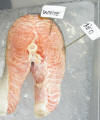Biology 201
Ichthyology
In this table, most of the images are
links to outside sources; the images are more ideal than what I could take of
the specimens in the lab.
|
Station |
|
|
Diversity |
|
|
1.1 |
|
|
1.2 |
|
|
1.3 |
|
|
1.4 |
|
|
Anatomy |
|
|
2.1 |
|
|
2.2 |
Scales: placoid (note this image shows over 20 scales), ganoid, ctenoid, cycloid |
|
2.3 |
Other external features. Example 1 (cloaca not visible) Example 2 (sharks do not have an operculum) |
|
2.5.1 |
|
|
2.5.2 |
|
|
Swimming Styles |
|
|
Modes |
anguilliform, subcarangiform, carangiform, thunniform, ostraciiform, labriform, rajiform, amiiform, balistiform, |
Swimming Videos
|
anguilliform |
|
|
subcarangiform |
|
|
carangiform |
mackerel
(best towards the end of the clip) |
|
thunniform |
tuna (of course!) |
|
ostraciiform |
robot, porcupine fish - sporadic use of the tail for
propulsion only, cowfish, box fish |
|
labriform |
|
|
rajiform |
|
|
amiiform |
|
|
balistiform |
|
|
|
|
|
cruiser |
|
|
maneuverer |
|
|
accelerator |
sculpin (not big accelerations), sculpin (shows huge fin area!) |
|
|
|
|
flying fish |
|
|
beetles |
|
|
scallops |
|
|
|
|




